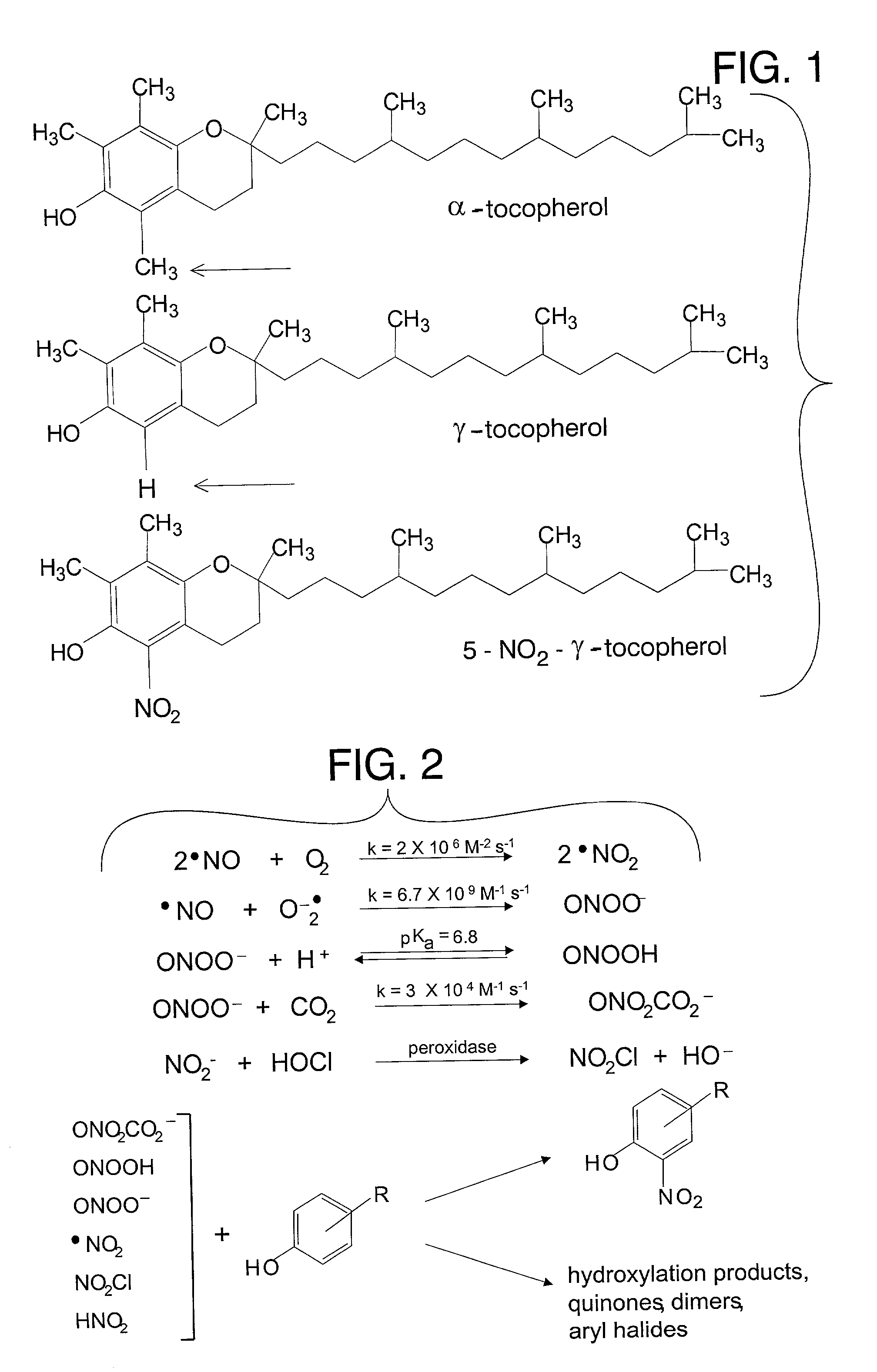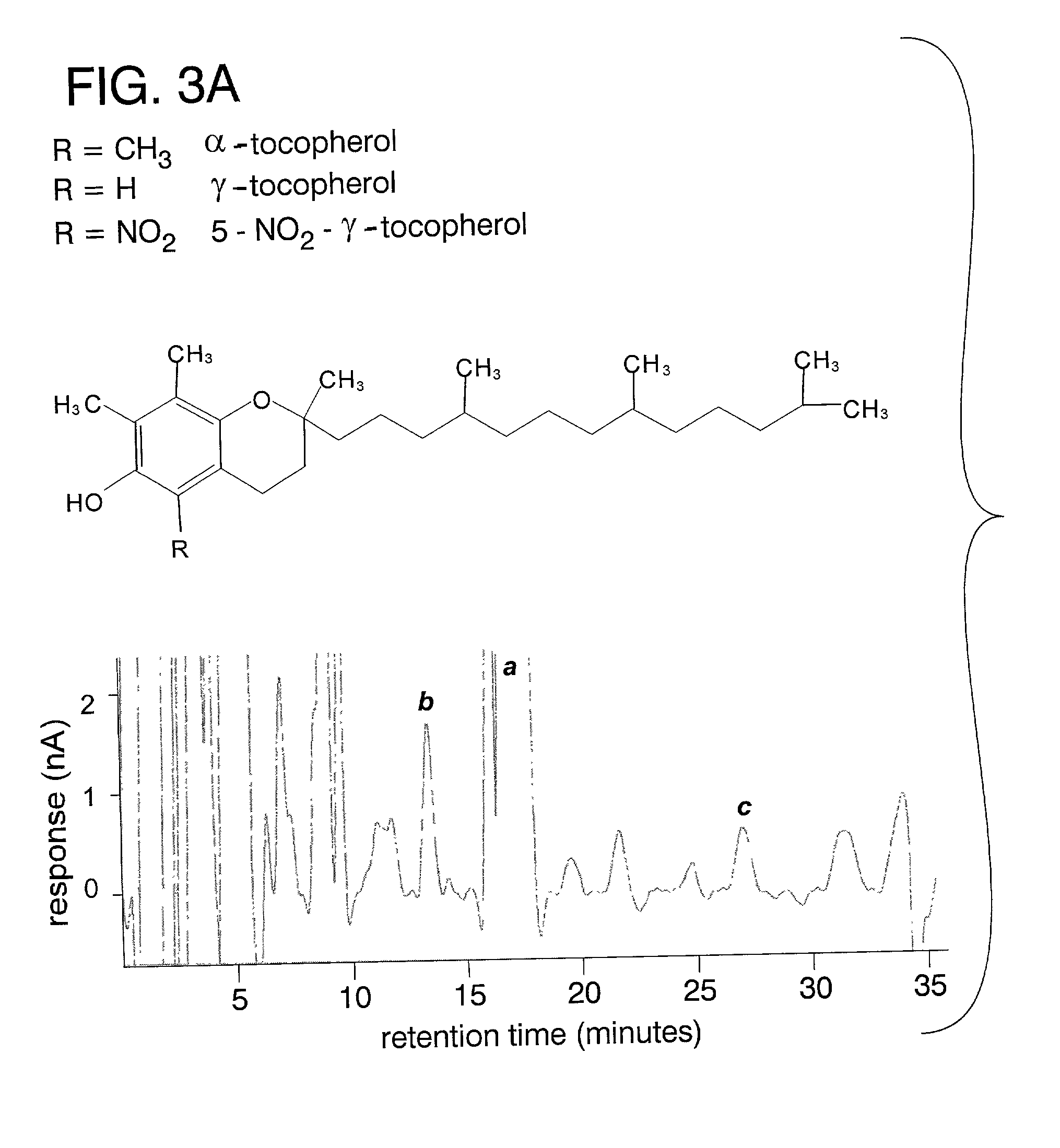Desmethyl tocopherols for preventing or slowing degenerative neurological diseases
a technology of desmethyl tocopherols and degenerative neurological diseases, applied in the field of desmethyl tocopherols for preventing or slowing degenerative neurological diseases, can solve problems such as depletion or nitration of desmethyl, and achieve the effect of slowing the progression of nitrative stress
- Summary
- Abstract
- Description
- Claims
- Application Information
AI Technical Summary
Problems solved by technology
Method used
Image
Examples
example 1
[0030] Demonstration that .gamma.-Tocopherol Scavenges RNS (reactive nitrogen species) in the Alzheimer's Diseased Brain
[0031] To study lipid-phase nitration chemistry, high performance liquid chromatography with electrochemical detection (HPLC-ECD) has been applied by the present inventors to the study of tocopherol variants and their oxidation products (18). By connecting a photodiode array detector in-line with (preceding) the ECD, at least 7 discreet tocopherol variants can be simultaneously quantified in hexane-extracted human plasma (18). In studies with brain tissue taken from Alzheimer's diseased (AD) and normal brains by rapid postmortem protocol (<3 H), a significant 2-3 fold increase can be seen in the 5-nitro-.gamma.-tocopherol .gamma.-tocopherol ratio in affected regions of the Alzheimer's diseased brain relative to age-matched normal brain (FIG. 3A and 3B). Concomitantly, the .gamma.T content of the cortical tissue decreased by 20-50% in AD depending on the brain regio...
example 2
[0032] Demonstration that Protein Nitration Occurs in the Alzheimer's Diseased Brain
[0033] Using HPLC-ECD techniques, we measured 2-7 fold increases in protein nitration and oxidation products in the Alzheimer's brain and published these results (11). As illustrated in FIG. 4, nitrotyrosine (3-NO.sub.2-Tyr) was significantly elevated in regions of the Alzheimer's diseased brain that are histologically affected by the disease.
example 3
[0034] Demonstration of .alpha.KGDH Protection Against Nitrative Stress by .gamma.-Tocopherol
[0035] The finding that human brain .alpha.KGDH activity correlates negatively with mitochondrial 5N.gamma.T stimulated us to ask whether .gamma.T could protect mitochondria from nitrative stress in vitro. Mitochondria were isolated from adult rat brain then sonicated briefly in the presence of either .alpha.T or .gamma.T, or an ethanol vehicle. Mitochondria were then exposed to SIN-1, which generates NO and superoxide simultaneously at a known rate (7). Combination of NO and superoxide yields ONOO.sup.- in situ (discussed above). Enzyme activity is destroyed by peroxynitrite and superoxide but not by NO (19). Predictably, .alpha.KGDH activity is diminished in lipopolysaccharide-treated cell culture in an RNS- dependent manner (19). FIG. 5 illustrates the protection of .alpha.KGDH by .alpha.T and .gamma.T present during exposure to the peroxynitrite (RNS)-generating compound SIN-1. A 400 .mu...
PUM
| Property | Measurement | Unit |
|---|---|---|
| water-soluble | aaaaa | aaaaa |
| lipophilic | aaaaa | aaaaa |
| concentration | aaaaa | aaaaa |
Abstract
Description
Claims
Application Information
 Login to View More
Login to View More - R&D
- Intellectual Property
- Life Sciences
- Materials
- Tech Scout
- Unparalleled Data Quality
- Higher Quality Content
- 60% Fewer Hallucinations
Browse by: Latest US Patents, China's latest patents, Technical Efficacy Thesaurus, Application Domain, Technology Topic, Popular Technical Reports.
© 2025 PatSnap. All rights reserved.Legal|Privacy policy|Modern Slavery Act Transparency Statement|Sitemap|About US| Contact US: help@patsnap.com



